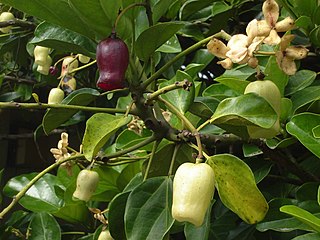
Bedd Arthur is a possibly Neolithic hengiform monument megalithic site in the Preseli Hills in the Welsh county of Pembrokeshire. Thirteen upright stones and at least 2 fallen ones, each around 0.6 metres (2.0 ft) high form an oval horseshoe with similarities to the earliest form of Stonehenge.

Strobilanthes is a genus of about 350 species of flowering plants in the family Acanthaceae, mostly native to tropical Asia and Madagascar, but with a few species extending north into temperate regions of Asia. Many species are cultivated for their two-lipped, hooded flowers in shades of blue, pink, white and purple. Most are frost-tender and require protection in frost-prone areas. The genus is most famed for its many species which bloom on long cycles of several years, such as Strobilanthes wightii which blooms every thirteen years.

Poeciloneuron indica is a species of flowering plant in the family Calophyllaceae. It is a tree endemic to India.
Colonel Richard Henry Beddome was a British military officer and naturalist in India, who became chief conservator of the Madras Forest Department. In the mid-19th century, he extensively surveyed several remote and then-unexplored hill ranges in Sri Lanka and south India, including those in the Eastern Ghats such as Yelandur, Kollegal, Shevaroy Hills, Yelagiri, Nallamala Hills, Visakhapatnam hills, and the Western Ghats such as Nilgiri hills, Anaimalai hills, Agasthyamalai Hills and Kudremukh. He described many species of plants, amphibians, and reptiles from southern India and Sri Lanka, and several species from this region described by others bear his name.

Cefn-y-bedd railway station serves the village of Cefn-y-bedd in Flintshire, Wales. The station is 4 miles (6 km) north of Wrexham Central on the Borderlands Line. It was opened in 1866 by the Wrexham, Mold and Connah's Quay Railway, which later became part of the Great Central Railway system.

Carissa spinarum, the conkerberry or bush plum, is a large shrub of the dogbane family (Apocynaceae), widely distributed in tropical regions of Africa, Southern Asia, Australia, and various islands of the Indian Ocean. It is most well known in Australia, where it is also called currant bush or, more ambiguously, native currant or even black currant. It is, however, neither closely related to plums (Prunus) nor to true currants (Ribes), which belong to entirely different lineages of eudicots. In India, it is also called wild karanda /wild karavanda, referring to the related karanda. Carissa spinarum is often discussed under its many obsolete synonyms.

Humboldtia is a genus of flowering plants in the family Fabaceae. It includes eight species of trees and shrubs native to India and Sri Lanka. Most species are endemic to the Western Ghats of southwestern India, with one species ranging southwards to Sri Lanka. Typical habitats include tropical lowland and montane rain forest, often along rivers.

Cefn-y-bedd is a village in Flintshire, north-east Wales.

Poeciloneuron pauciflorum is a species of flowering plant in the family Calophyllaceae. It was recorded in Travancore and Tirunelveli in 19th century India. It has not been recorded since. The specific epithet pauciflora is Latin for 'few-flowered'.

Atuna is a genus of plants in the family Chrysobalanaceae described as a genus in 1838. It is native to the Indian Subcontinent, Southeast Asia, and various islands of the western Pacific.

Hopea is a genus of plants in the family Dipterocarpaceae. It contains some 113 species, distributed from Sri Lanka and southern India to the Andaman Islands, Myanmar, southern China, and southward throughout Malesia to New Guinea. They are mainly main and subcanopy trees of lowland rainforest, but some species can become also emergent trees, such as Hopea nutans.

Nothopegia is a genus of plants in the family Anacardiaceae.

Polyalthia is a genus of flowering plants in the family Annonaceae. There are approximately 90 species distributed from Africa to Asia and the Pacific.

Saprosma fragrans is a species of plant in the family Rubiaceae. It is endemic to the region of Assam.

Saprosma is a genus of flowering plants in the family Rubiaceae. There are about 40 species distributed from south China to tropical Asia.

Semecarpus auriculatus is a species of plant in the family Anacardiaceae. It is endemic to India. The specific epithet was originally spelt auriculata.

Semecarpus travancoricus is a species of plant in the family Anacardiaceae native to India and Bangladesh. The specific epithet was originally spelt travancorica. In India, it is found in the southern Western Ghats in South India. It is a tree of evergreen forests and is found only south of the Anamalais at an elevation around 1300 MSL.

Christella is a genus of around 70-80 species of ferns in the subfamily Thelypteridoideae of the family Thelypteridaceae in the Pteridophyte Phylogeny Group classification of 2016. Other sources sink Christella into a very broadly defined genus Thelypteris. The genus was named after Konrad H. Christ, a Swiss botanist. The distribution of these plants is mostly in the tropics and sub tropical areas. An Australian example is C. dentata.

Eglwys y Bedd is all that remains of a 14th-century church in Anglesey, north Wales. It is set within the churchyard of St Cybi's, Holyhead, and may have been built on the site where Cybi lived and ministered. It is reputed to house the grave of Seregri, an Irish warrior who lived in the area in the 5th century.

Goniophlebium is a genus of ferns in the family Polypodiaceae, subfamily Microsoroideae, according to the Pteridophyte Phylogeny Group classification of 2016 (PPG I).



















